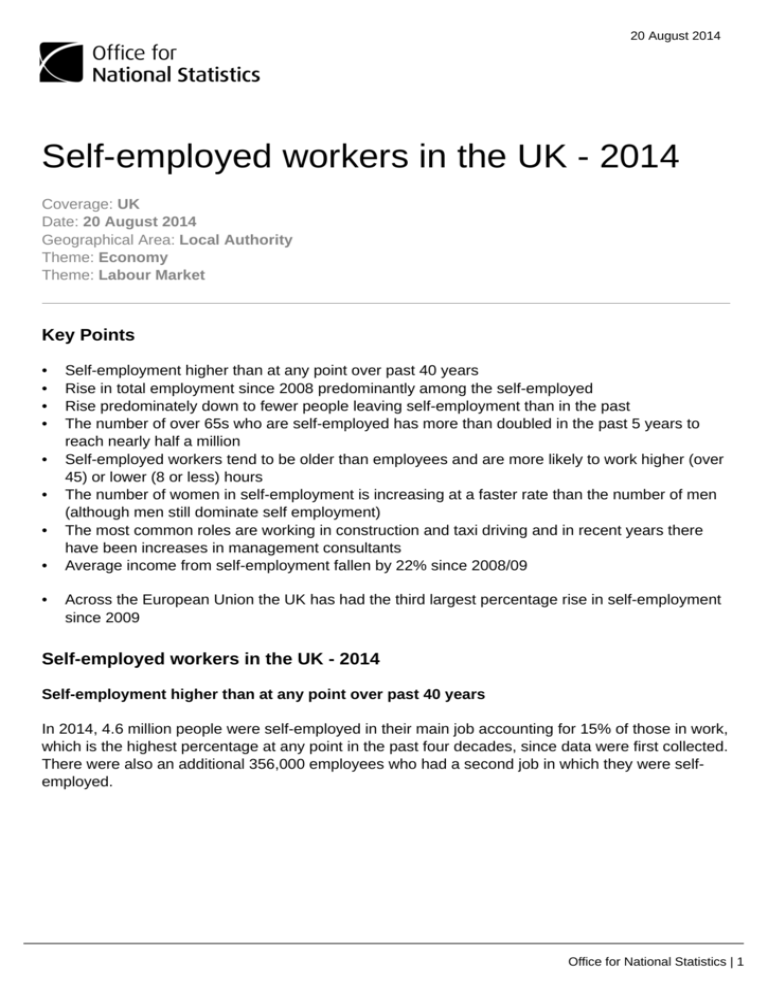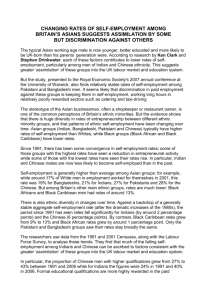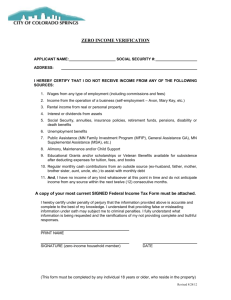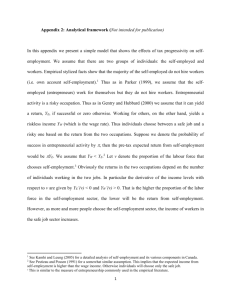Self-employed workers in the UK - 2014
advertisement

20 August 2014 Self-employed workers in the UK - 2014 Coverage: UK Date: 20 August 2014 Geographical Area: Local Authority Theme: Economy Theme: Labour Market Key Points • • • • • • • • • Self-employment higher than at any point over past 40 years Rise in total employment since 2008 predominantly among the self-employed Rise predominately down to fewer people leaving self-employment than in the past The number of over 65s who are self-employed has more than doubled in the past 5 years to reach nearly half a million Self-employed workers tend to be older than employees and are more likely to work higher (over 45) or lower (8 or less) hours The number of women in self-employment is increasing at a faster rate than the number of men (although men still dominate self employment) The most common roles are working in construction and taxi driving and in recent years there have been increases in management consultants Average income from self-employment fallen by 22% since 2008/09 Across the European Union the UK has had the third largest percentage rise in self-employment since 2009 Self-employed workers in the UK - 2014 Self-employment higher than at any point over past 40 years In 2014, 4.6 million people were self-employed in their main job accounting for 15% of those in work, which is the highest percentage at any point in the past four decades, since data were first collected. There were also an additional 356,000 employees who had a second job in which they were selfemployed. Office for National Statistics | 1 20 August 2014 Percentage of people in work who are self-employed, 1975-2014, UK Source: Labour Force Survey - Office for National Statistics Download chart XLS format (78 Kb) Office for National Statistics | 2 20 August 2014 Looking over the past 40 years, self-employment generally rose throughout the 1980s until the mid 1990s although there was a slight fall during the early 1990s recession. Around this time there was a decline in manufacturing and an increase in service led activities as well as a shift amongst many employers to contract out many services. There were also general increases in entrepreneurial activity supported by government programmes such as the Enterprise Allowance Scheme (EAS). Subsequent governments have introduced similar schemes, the most recent being the New Enterprise Allowance, which was set up in 2011. Selfemployment fell during the late 1990s with much of this fall within the construction industry. Around this time there was an initiative led by the Inland Revenue in 1996 which saw many self-employed became employees. Also during the resultant recovery after the 1990s recession many people may have moved to become an employee rather than being self-employed. From the turn of the millennium self-employment started to rise again. Rise in total employment since 2008 predominantly among the self-employed Total employment in the second quarter of 2014 was 1.1 million higher than in the first quarter of 2008, just before the economic downturn that hit the UK. Of this increase, 732,000 was among people who are self-employed so the rise in total employment since 2008 was predominantly among the self-employed. The total number of employees rose by 339,000 over the same period. Comparing 2014 with 2008 hides some important changes that have happened over the period such as: • • • Following the economic downturn in 2008 the total number of people employed in the UK started to fall and by the first quarter of 2010 total employment was 700,000 lower than it was two years previously. Between 2008 and 2010 self-employment did not take the same hit as employees. By the first quarter of 2010 self-employment was 69,000 higher than in 2008 while the total number of employees was 759,000 lower. After this decline in the number of employees, the total number of employees rose by 1.1 million between the first quarter of 2010 and second quarter of 2014. Self-employment rose by 663,000 over this period. Office for National Statistics | 3 20 August 2014 Change in the number of employees and self-employed workers compared to the first quarter of 2008, UK Source: Labour Force Survey - Office for National Statistics Download chart XLS format (32.5 Kb) Office for National Statistics | 4 20 August 2014 Rise in self-employment is predominately down to fewer people leaving self-employment than in the past Of the 4.6 million self-employed workers in 2014, 36%, or 1.7 million workers had started their selfemployment role since 2009. As self-employment was 783,000 higher than in 2009 this implies that 886,000, or 23%, of those who were self-employed in 2009 had left by 2014. The percentage of people starting self-employment, also known as the inflow rate, over the past 20 years has been fairly constant, hovering around 36% to 38%. The percentage of people leaving self-employment, or the outflow rate, was between 32% and 37% until the most recent five-year period where it fell to 23%. Therefore the rise in self-employment is predominately down to fewer people leaving selfemployment than in the past. Why people are not leaving self-employment is not asked but the fall in the outflow from selfemployment could be down to several economic and social factors which may include: • • More people (both those self-employed and those working as employees) are continuing to work beyond the default state pension age. Self-employment among those aged 65 and over has doubled from 241,000 in 2009 to 428,000 in 2014. The opportunity to work as an employee fell at the onset of the economic downturn which limited the opportunity for people to move from self-employment. Office for National Statistics | 5 20 August 2014 Inflows to and outflows from self-employment for each 5-year period since 1994, UK Source: Labour Force Survey - Office for National Statistics Download chart XLS format (29 Kb) Largest increase in self-employment in the Managers, Directors and Senior Officials occupation group Office for National Statistics | 6 20 August 2014 Change in the number of self-employed people in each occupational grouping between 2009 and 2014, UK Office for National Statistics | 7 20 August 2014 Source: Labour Force Survey - Office for National Statistics Download chart XLS format (23 Kb) The nature of self-employment is such that many people manage their business and are therefore likely to state they are in a managerial role despite the level of responsibility they may have. Managerial occupations including roles within property, marketing and finance have seen the largest rise in self-employment over the past five years, with an increase of around 237,000 people. Accounting for over one quarter of all people who are self-employed, skilled trade occupations are the most common roles. Construction and carpentry and joinery are among the most popular job roles for the self-employed, along with taxi and cab drivers and chauffeurs. However there has been some volatility within these types of roles, in particular within construction over the downturn and recovery. In 2009 the construction industry was the most common sector for the self-employed, but the economic crisis hit this sector the hardest, to the extent that comparing 2014 to 2009 it had the slowest growth in self-employment compared with other major industry groups. Instead the rise in self-employment was largest in professional, scientific and technical activities which include roles such as management consultancy, book-keepers, photographers and chartered accountants. Self-employed workers tend to be older than employees Office for National Statistics | 8 20 August 2014 Perecentage of each age group that are self-employed and employees, 2014, UK Source: Labour Force Survey - Office for National Statistics Download chart XLS format (30 Kb) Self-employed workers tend to be older than employees, with 43% of those self-employed being aged 50 and over, compared with 27% of employees. The average age of a self-employed worker in 2014 was 47, 7 years higher than the average age of an employee. Self-employed more likely to work higher or lower hours compared with employees In 2014, the average hours worked by people who were self-employed was 40 hours, 2 hours more than employees at 38 hours. Office for National Statistics | 9 20 August 2014 Percentage of employees and the self-employed by the number of hours they usually work, April-June 2014, UK Source: Labour Force Survey - Office for National Statistics Download chart XLS format (37 Kb) 35% of self-employed workers usually worked 45 hours or more per week in 2014, compared with 23% of employees. Within this group, 13% of self-employed people usually worked 60 hours or more per week compared with just 4% of employees. However, self-employed people were also more likely than employees to work shorter hours with 5% working 8 hours or less per week, compared with 2% for employees. The number of women in self-employment is increasing at a faster rate than the number of men In 2014 women made up just under one third of the self-employed (1.4 million). Since 2009 the number of self-employed women has increased by 34%. By comparison over the past five years the number of self-employed men has risen by 15% to 3.1 million in 2014. Despite the rise in women being self-employed, men still make up 68% of self-employed workers. Office for National Statistics | 10 20 August 2014 Work in skilled trades in male-dominated industries such as construction have suffered more from the effects of the economic crisis than the service sector and professional occupations that selfemployed women tend to work in. This can help to explain why the number of women in selfemployment has been increasing at double the rate that it has for men. The top three occupations for self-employed women are cleaners and domestics, childminders and related occupations and hairdressers and barbers. Average median income from self-employment fallen by 22% since 2008/09 In 2012/13 the average median income from self-employment was £207 per week, according to the Family Resource Survey, a fall of 22% (after taking into account inflation) since 2008/09. Note thought that household surveys generally underestimate income from self-employment as income generally comes from a wide variety of different sources and the estimate relies on respondent recall which can often be difficult. The figures for the income of the self-employed will include those individuals who made a loss in their business and hence in theory had a negative income for the year, whereas employees do not earn a negative wage. Self-employed workers also do not get the same benefits that employees do in terms of paid leave, sick pay or maternity pay. Median self-employed income, 2002/03 - 2012/13, UK Office for National Statistics | 11 20 August 2014 Source: Family Resources Survey - Work and Pensions Download chart XLS format (27.5 Kb) London had the highest concentration of self-employment Looking across the regions of England along with Scotland and Wales, 17.3% of Londoners in work were self-employed. The second highest self-employment rate was in the South Wes at 16.6% followed by the South East at 15.8%. The North East had the lowest self-employment rate at 10.8%. Percentage of workers who are self-employed in each region and devolved country of the UK, April-June 2014, GB Source: Annual Population Survey (APS) - Office for National Statistics Office for National Statistics | 12 20 August 2014 Download chart XLS format (28 Kb) London and the South East have seen the largest increase in self-employment as a percentage of all workers since 2008 at 2.0 percentage points, closely followed by the West Midlands and North West at 1.9 percentage points. Yorkshire and The Humber had the smallest increase at 0.7 percentage points. Local authorities in the South West had some of the highest self-employment rates Using information from the 2011 Census, the Isles of Scilly had the highest self-employment rate of any local authority, with 33.2% of people in work being self-employed. This was followed by the Orkney Islands with 28.2% and West Somerset with 27.8%. Office for National Statistics | 13 20 August 2014 Percentage of workers who are self-employed by local authority, top and bottom 5, 2011, GB Office for National Statistics | 14 20 August 2014 Source: Census - Office for National Statistics Download chart XLS format (27 Kb) The local authority with the lowest self-employment rate was Corby in the East Midlands, at 8.7%. This was followed by West Dunbartonshire in Scotland at 8.9% and Kingston upon Hull in Yorkshire and The Humber at 9.0%. Greece has the highest self-employment rate in the EU In the first quarter of 2014, Greece had the highest self-employment rate in the European Union at 32.0%, followed by Italy at 23.6% and Romania at 20.4%. The self-employment rate expresses the proportion of people in work that are self-employed. Greece’s high rate of self-employment is a product of its large agricultural sector and the effects of tourism. The average self-employment rate within the EU for 2014 was 15.2%, slightly higher than the rate for the UK. The EU countries with the lowest rate of self-employment in 2014 were Luxembourg at 8.1%, Denmark at 9.0% and Estonia at 9.4%. Percentage of workers who are self-employed in EU countries, Q1 2014 Source: Eurostat Office for National Statistics | 15 20 August 2014 Download chart XLS format (30 Kb) Across the European Union the UK has had the third largest percentage rise in selfemployment since 2009 Comparing January-March 2014 with the same period in 2009, self-employment increased by around 19% in the UK, equivalent to around 720,000 people. This percentage increase was the third highest in the EU, behind Slovenia (23%) and Estonia (20%), although these countries are relatively small in comparison. Percentage change in self-employment between 2009 and 2014 for EU countries Source: Eurostat Download chart XLS format (31 Kb) Office for National Statistics | 16 20 August 2014 The average for the EU was a decrease of 0.1% in the number of self-employed workers between 2009 and 2014. The largest falls in self-employment were in Croatia, Portugal and Greece. Background notes 1. Sources: • • • • • Labour Force Survey, ONS Annual Population Survey, ONS 2011 Census, ONS Family Resources Survey, DWP European Labour Force Survey, Eurostat All UK analysis uses the quarterly LFS person datasets for April to June 2014 Income analysis uses the Family Resources Survey All regional analysis uses the annual APS datasets for January to December 2013 All Local Authority level analysis uses the 2011 Census All European analysis uses the European Labour Force Survey datasets for Quarter 1 for 2009 and 2014 2. Self-employed are workers who directly provide services and do not have a contract of employment, based on the respondents view of the type of work they do. • • • • • The self-employment rate is the number of self-employed aged 16 and over as a percentage of those in employment aged 16 and over. The inflows and outflows from self-employment are the differences in self-employment between two fixed periods in time, five years apart. They do not state the total number of people that have entered and left self-employment between these two periods in time. There are people that will enter and leave self-employment in between these periods that cannot be accounted for. Hours worked is the total usual hours worked in main job (including overtime) Occupation group is based on the Standard Occupation Classification (SOC) 2010 major groups. Datasets before 2010 that use SOC 2000 groups have been reclassified to SOC 2010 standards for comparison. The occupation group is not available for some workers and these have been excluded from the tables. Industry group is based on the Standard Industry Classification (SIC) 2007 sectors. The industry sector is not available for some workers and these have been excluded from the tables. 3. The Consumer Prices Index of inflation is used to adjust income for inflation 4. Details of the policy governing the release of new data are available by visiting www.statisticsauthority.gov.uk/assessment/code-of-practice/index.html or from the Media Relations Office email: media.relations@ons.gsi.gov.uk Office for National Statistics | 17 20 August 2014 These National Statistics are produced to high professional standards and released according to the arrangements approved by the UK Statistics Authority. Copyright © Crown copyright 2014 You may use or re-use this information (not including logos) free of charge in any format or medium, under the terms of the Open Government Licence. To view this licence, visit www.nationalarchives.gov.uk/doc/open-government-licence/ or write to the Information Policy Team, The National Archives, Kew, London TW9 4DU, or email: psi@nationalarchives.gsi.gov.uk. This document is also available on our website at www.ons.gov.uk. Office for National Statistics | 18





